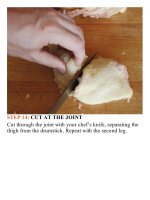The food lab better home cooking through science ( PDFDrive ) 363
Bạn đang xem bản rút gọn của tài liệu. Xem và tải ngay bản đầy đủ của tài liệu tại đây (102.38 KB, 2 trang )
steaks before and after cooking. Aside from a
minimal amount of weight loss due to rendered fat,
the vast majority of weight loss comes from juices
that are forced out of the meat. When cooked to
130°F,asteaklosesaround12percentofitsweight
during cooking. Cut it open immediately, and you
loseanadditional9percent.Butallowittorest,and
you can keep the additional weight loss down to
around2percent.
Resting is not just for steaks, by the way. At a
fundamental level, pretty muchallmeatbehavesthe
same way, whether it’s a 30-pound standing rib
roast or a 6-ounce chicken breast. The only
differences are that just as cooking times are
different for different-sized pieces of meat, so are
resting times. By far the easiest and most foolproof
way to test if your meat has rested long enough is
the same way you can tell if your meat is cooked
properly:withathermometer.
Ideally, no matter how well-done you’ve cooked
yourmeat,youwanttoallowittocooluntilthevery
center is about 5 degrees below its maximum
temperature.Soforamedium-rare130°Fsteak,you
shouldallowittocooltoatleast125°Finthecenter
before serving.At this stage, the muscle fibers have
relaxedenoughandthejuiceshavethickenedenough
that you should have no problem with losing juices.
With in a 1½-inch-thick steak or a whole chicken
breast, this translates to around 10 minutes. For a
primerib,itmaytakeaslongas45minutes.
Afraid your steak will lose its crust as it rests?
Easy solution: Reheat its pan drippings (or melt a
panfulofbutterifyoucookedthesteakonthegrill)
and pour, smoking hot, over the steak just before
serving.









